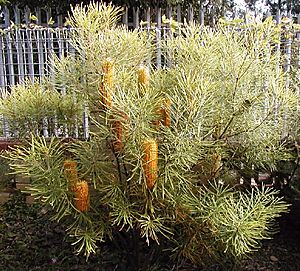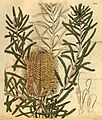Banksia spinulosa var. collina facts for kids
Quick facts for kids Banksia spinulosa var. collina |
|
|---|---|
 |
|
| B. spinulosa var. collina 'Carnarvon Gold' | |
| Scientific classification |
|
| Kingdom: | Plantae |
| Clade: | Tracheophytes |
| Clade: | Angiosperms |
| Clade: | Eudicots |
| Order: | Proteales |
| Family: | Proteaceae |
| Genus: | Banksia |
| Species: | |
| Varietas: |
B. s. var. collina
|
| Trinomial name | |
| Banksia spinulosa var. collina (R.Br.) A.S.George
|
|
Banksia spinulosa var. collina is a beautiful shrub that grows along the eastern coast of Australia. You can find it in Queensland and New South Wales. People often call it the Hill Banksia or Golden Candlesticks because of its bright flowers. It's a type, or variety, of the Hairpin Banksia. This plant is very popular and you can often buy it at plant nurseries for your garden.
Contents
What it Looks Like
Like other types of Hairpin Banksia, Banksia spinulosa var. collina grows as a shrub with many stems. It has special underground stems called lignotubers that help it regrow after a fire. Its flower spikes are usually golden, or sometimes golden with red or purple tips.
The leaves of B. spinulosa var. collina are wider than those of the spinulosa variety. They often have small teeth along their edges, but not always. You can tell it apart from Banksia spinulosa var. cunninghamii because collina has those underground stems and lots of stems above ground.
How it Got its Name
The Banksia spinulosa var. collina was first described by a botanist named Robert Brown in 1810. He found specimens of this plant near the Hunter River in New South Wales in 1802.
Brown named it "collina" because it comes from the Latin word collinus, which means "of hills." He found it growing in hilly areas. However, this plant actually grows in many different types of places, not just hills!
Over time, scientists have studied and reclassified plants many times. In 1981, a botanist named Alex George grouped Banksia collina as a variety of Banksia spinulosa. This is why its full name is Banksia spinulosa var. collina.
Here's how scientists currently classify B. spinulosa var. collina:
- Genus Banksia
- Subgenus Banksia
- Section Oncostylis
- Series Spicigerae
- Section Oncostylis
- Subgenus Banksia
*'''B. spinulosa **B. spinulosa var. spinulosa **'''B. spinulosa var. collina **B. spinulosa var. neoanglica **B. spinulosa var. cunninghamii
Where it Grows
This plant mostly grows along the coast from Gympie in Queensland down to Sydney. You can also find some groups of them in other places like Carnarvon National Park, Crows Nest, and Mount Barney National Park in Queensland. There's also a group at Boonoo Boonoo in New South Wales.
It usually grows in sandy soil that sits on top of sandstone. But it can also grow in heavier soils. You'll often see it as a smaller shrub under taller Eucalyptus trees in open forests and woodlands.
Growing it in Your Garden
Many people like to grow Banksia spinulosa var. collina in their gardens because it's very attractive. However, it can look quite different from one plant to another. It grows slowly, and it might take up to eight years for the first flowers to appear!
This plant is quite tough. It can handle many different types of soil and sunlight conditions. It can even survive cold frosts down to about -8 degrees Celsius (17.6 degrees Fahrenheit). You can also prune it quite a lot to shape it.
Some special types of this plant that you might find in nurseries include Banksia "Stumpy Gold" and Banksia "Carnarvon Gold".
Images for kids



